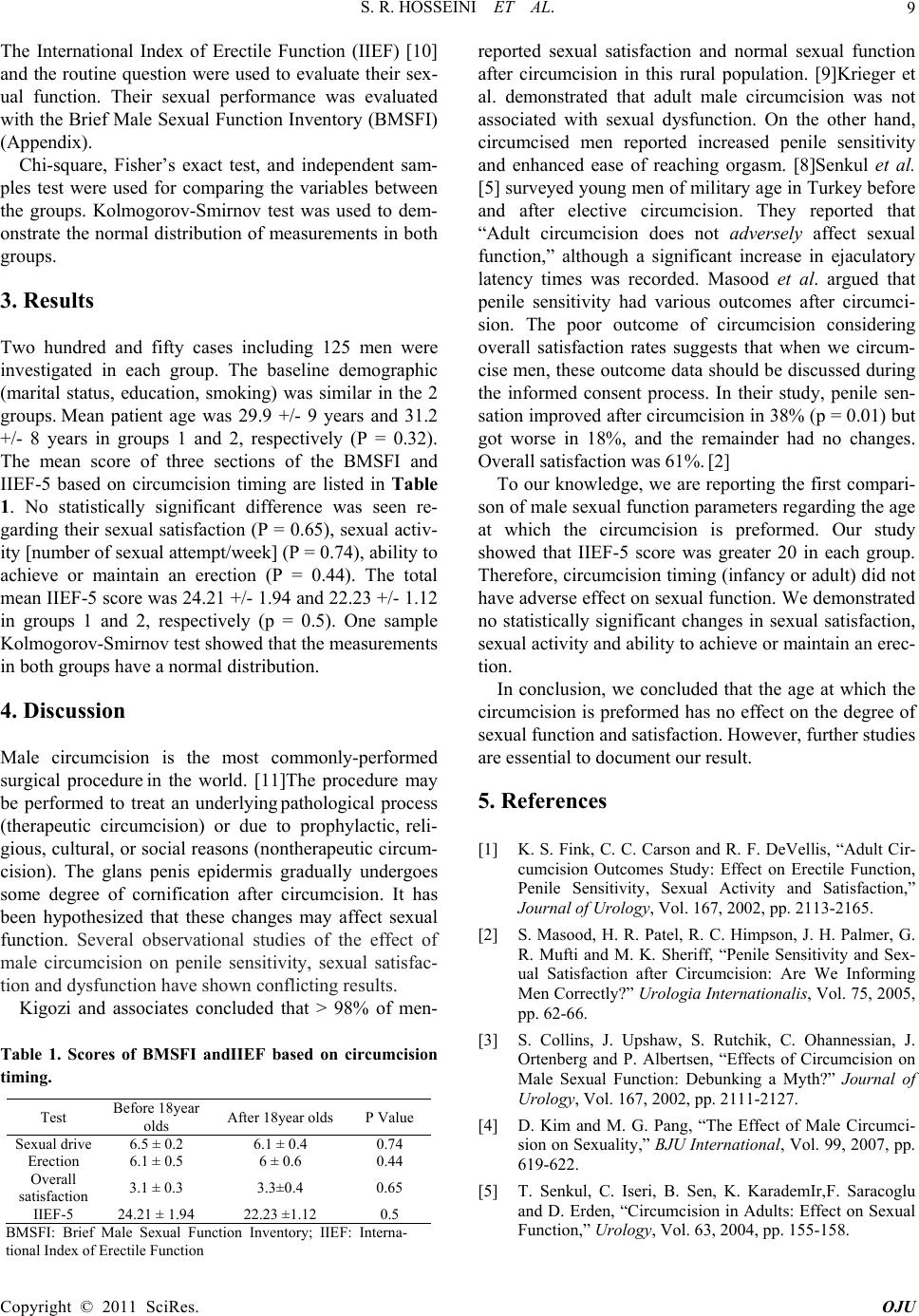
S. R. HOSSEINI ET AL.9
The International Index of Erectile Function (IIEF) [10]
and the routine question were used to evaluate their sex-
ual function. Their sexual performance was evaluated
with the Brief Male Sexual Function Inventory (BMSFI)
(Appendix).
Chi-square, Fisher’s exact test, and independent sam-
ples test were used for comparing the variables between
the groups. Kolmogorov-Smirnov test was used to dem-
onstrate the normal distribution of measurements in both
groups.
3. Results
Two hundred and fifty cases including 125 men were
investigated in each group. The baseline demographic
(marital status, education, smoking) was similar in the 2
groups. Mean patient age was 29.9 +/- 9 years and 31.2
+/- 8 years in groups 1 and 2, respectively (P = 0.32).
The mean score of three sections of the BMSFI and
IIEF-5 based on circumcision timing are listed in Table
1. No statistically significant difference was seen re-
garding their sexual satisfaction (P = 0.65), sexual activ-
ity [number of sexual attempt/week] (P = 0.74), ability to
achieve or maintain an erection (P = 0.44). The total
mean IIEF-5 score was 24.21 +/- 1.94 and 22.23 +/- 1.12
in groups 1 and 2, respectively (p = 0.5). One sample
Kolmogorov-Smirnov test showed that the measurements
in both groups have a normal distribution.
4. Discussion
Male circumcision is the most commonly-performed
surgical procedure in the world. [11]The procedure may
be performed to treat an underlying pathological process
(therapeutic circumcision) or due to prophylactic, reli-
gious, cultural, or social reasons (nontherapeutic circum-
cision). The glans penis epidermis gradually undergoes
some degree of cornification after circumcision. It has
been hypothesized that these changes may affect sexual
function. Several observational studies of the effect of
male circumcision on penile sensitivity, sexual satisfac-
tion and dysfunction have shown conflicting results.
Kigozi and associates concluded that > 98% of men-
Table 1. Scores of BMSFI andIIEF based on circumcision
timing.
Test Before 18year
olds After 18year olds P Value
Sexual drive 6.5 ± 0.2 6.1 ± 0.4 0.74
Erection 6.1 ± 0.5 6 ± 0.6 0.44
Overall
satisfaction 3.1 ± 0.3 3.3±0.4 0.65
IIEF-5 24.21 ± 1.94 22.23 ±1.12 0.5
BMSFI: Brief Male Sexual Function Inventory; IIEF: Interna-
tional Index of Erectile Function
reported sexual satisfaction and normal sexual function
after circumcision in this rural population. [9]Krieger et
al. demonstrated that adult male circumcision was not
associated with sexual dysfunction. On the other hand,
circumcised men reported increased penile sensitivity
and enhanced ease of reaching orgasm. [8]Senkul et al.
[5] surveyed young men of military age in Turkey before
and after elective circumcision. They reported that
“Adult circumcision does not adversely affect sexual
function,” although a significant increase in ejaculatory
latency times was recorded. Masood et al. argued that
penile sensitivity had various outcomes after circumci-
sion. The poor outcome of circumcision considering
overall satisfaction rates suggests that when we circum-
cise men, these outcome data should be discussed during
the informed consent process. In their study, penile sen-
sation improved after circumcision in 38% (p = 0.01) but
got worse in 18%, and the remainder had no changes.
Overall satisfaction was 61%. [2]
To our knowledge, we are reporting the first compari-
son of male sexual function parameters regarding the age
at which the circumcision is preformed. Our study
showed that IIEF-5 score was greater 20 in each group.
Therefore, circumcision timing (infancy or adult) did not
have adverse effect on sexual function. We demonstrated
no statistically significant changes in sexual satisfaction,
sexual activity and ability to achieve or maintain an erec-
tion.
In conclusion, we concluded that the age at which the
circumcision is preformed has no effect on the degree of
sexual function and satisfaction. However, further studies
are essential to document our result.
5. References
[1] K. S. Fink, C. C. Carson and R. F. DeVellis, “Adult Cir-
cumcision Outcomes Study: Effect on Erectile Function,
Penile Sensitivity, Sexual Activity and Satisfaction,”
Journal of Urology, Vol. 167, 2002, pp. 2113-2165.
[2] S. Masood, H. R. Patel, R. C. Himpson, J. H. Palmer, G.
R. Mufti and M. K. Sheriff, “Penile Sensitivity and Sex-
ual Satisfaction after Circumcision: Are We Informing
Men Correctly?” Urologia Internationalis, Vol. 75, 2005,
pp. 62-66.
[3] S. Collins, J. Upshaw, S. Rutchik, C. Ohannessian, J.
Ortenberg and P. Albertsen, “Effects of Circumcision on
Male Sexual Function: Debunking a Myth?” Journal of
Urology, Vol. 167, 2002, pp. 2111-2127.
[4] D. Kim and M. G. Pang, “The Effect of Male Circumci-
sion on Sexuality,” BJU International, Vol. 99, 2007, pp.
619-622.
[5] T. Senkul, C. Iseri, B. Sen, K. KarademIr,F. Saracoglu
and D. Erden, “Circumcision in Adults: Effect on Sexual
Function,” Urology, Vol. 63, 2004, pp. 155-158.
Copyright © 2011 SciRes. OJU